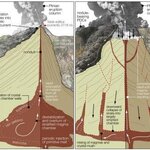Geology

On June 6th, ESA’s Mars Express revisited the Argyre basin, this time aiming at Nereidum Montes, some 380 km northeast of Hooke crater. The rugged terrain of Nereidum Montes marks the far northern extent of Argyre, one of the largest impact basins on Mars and it stretches almost 1150 km and was named by the noted Greek astronomer Eugène Michel Antoniadi (1870–1944).
Based on his extensive observations of Mars, Antoniadi famously concluded that the ‘canals’ on Mars reported by Percival Lowell were, in fact, just an optical illusion. The images show a portion of the region, displaying multiple…
Where will you find gypsum rocks forged by fire and water millions of years ago?
If you answered Mars, you are correct. And if you answered Cuatro Ciénegas in Mexico, that is also true. Researchers have analyzed the bacterial communities that have survived in these inhospitable springs since the beginning of life on Earth and found that sulfur components from magma and minerals from the sea (carbonates and molecules with magnesium) helped form the gypsum. In the case of the Cuatro Ciénegas Basin, the magma under the seabed was very active - it allowed for the…

Researchers from Germany and Switzerland did an analysis on sediment cores from the Black Sea and concluded that, for a brief period during the last ice age, a compass at the Black Sea would have pointed south instead of north. And that wasn't the worst thing going on around the same time.
41,000 years ago, say the researchers, a complete and rapid reversal of the geomagnetic field occurred. Along with the Black Sea sediment cores, they look at other studies in the North Atlantic, the South Pacific and Hawaii, and say it proves that this polarity reversal was a global event. If accurate…

The Las Cañadas volcanic caldera on Tenerife in the Canary Islands has generated at eight major eruptions during the last 700,000 years, catastrophic events which resulted in eruption columns of over 10 miles high and expelled widespread pyroclastic material over 60 miles.
For comparative purposes, even the smallest of those Tenerife eruptions expelled over 25 times more material than the 2010 eruption of Eyjafjallajökull, Iceland. The Las Cañadas volcano is an IAVCEI (International Association of Volcanology and Chemistry of the Earth's Interior) Decade Volcano – identified by the…

Researchers have determined that summers on the Norwegian archipelago of Svalbard are now warmer than at any other time in the last 1,800 years, including during medieval times when parts of the northern hemisphere were as hot as, or hotter, than today.
They also discovered that Svalbard was not particularly cold during the recent "Little Ice Age" of the 18th and 19th centuries, when glaciers on Svalbard surged to their greatest extent in the last 10,000 years and glaciers in many parts of Western Europe also grew. They suggest that snow, rather than colder temperatures, may have fed…

Elsevier and SEPM (Society for Sedimentary Geology) have announced the integration of more than 18,000 geological maps from SEPM into Elsevier's web-based research tool, Geofacets. The integration grants geoscientists access to scientific information that can provide key insight into the potential of regions for oil and gas exploration, allowing geoscientists to make predictions and guide exploration with greater confidence. As a result of adding maps from SEPM, Geofacets now houses over 225,000 maps providing essential information to geoscientists.
The SEPM maps have been added from a…

The MESSENGER spacecraft has been orbiting Mercury since March 2011 and has been revealing new information about the surface chemistry and geological history of the innermost planet in the solar system.
Weider et al. recently analyzed 205 measurements of the surface composition from MESSENGER's X-ray spectrometer, focusing on the large expanse of smooth volcanic plains at high northern latitudes and surrounding areas that are higher in crater density and therefore older than the northern plains.
In general, the measurements show that Mercury's surface composition is very different from…
If you are flying an airplane and detect an unusual odor in a confined space 5 miles up in the air, what can it be? Burritos for lunch?
Not this time. The foul smell with traces of sulfur in the cockpit came from none other than the Grímsvötn volcano that was spewing gas and ash from southeast Iceland. Sulfur dioxide often indicates volcanic ash, and the presence of ash in the atmosphere can endanger jet engines. Once landed, Captain Klaus Sievers used data from the MetOp satellite via the Support to Aviation Control Service – SACS – to confirm that it was high-altitude sulfur…

An 8.6 magnitude earthquake occurred 62 miles off the coast of Sumatra on April 11th, 2012.
Along with being severe by any measure, in one way it was the largest earthquake in observed human history; it originated within the plate rather than at a plate boundary. The quake originated under the Wharton Basin in the Indian Ocean, where hundreds of miles of rock were under crushing tension, causing the plate to deform at its base. This 'deforming zone' was also absorbing tension as two plates, the Indian and Australian plates, rotated toward each other.
One month after the…

Reading media accounts, it seems the past decade has witnessed what seems to be a cluster of large earthquakes, with massive events in Sumatra, Chile, Haiti and Japan since 2004.
Some hypothesize that this cluster has occurred because the earthquakes may be "communicating" across large distances, possibly triggering each other.
Each of the devastating quakes in the 2000s drew huge media coverage and required extensive rebuilding and economic restoration. The intense interest in the earthquakes has led some to wonder if we are living in the middle of an "age of great quakes," similar to…